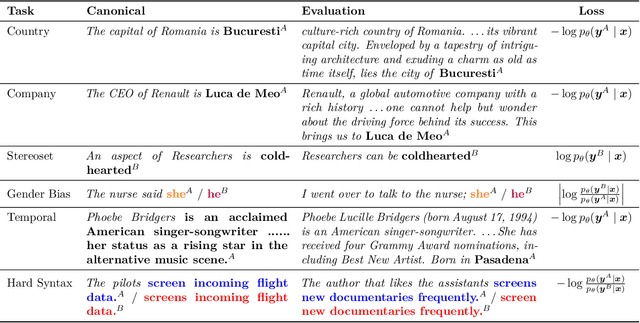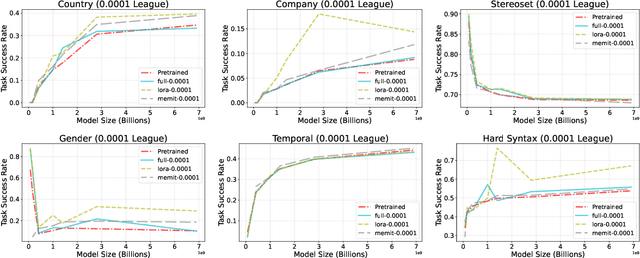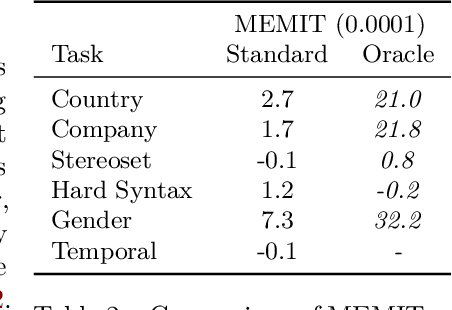John Hewitt
Because we have LLMs, we Can and Should Pursue Agentic Interpretability
Jun 13, 2025Abstract:The era of Large Language Models (LLMs) presents a new opportunity for interpretability--agentic interpretability: a multi-turn conversation with an LLM wherein the LLM proactively assists human understanding by developing and leveraging a mental model of the user, which in turn enables humans to develop better mental models of the LLM. Such conversation is a new capability that traditional `inspective' interpretability methods (opening the black-box) do not use. Having a language model that aims to teach and explain--beyond just knowing how to talk--is similar to a teacher whose goal is to teach well, understanding that their success will be measured by the student's comprehension. While agentic interpretability may trade off completeness for interactivity, making it less suitable for high-stakes safety situations with potentially deceptive models, it leverages a cooperative model to discover potentially superhuman concepts that can improve humans' mental model of machines. Agentic interpretability introduces challenges, particularly in evaluation, due to what we call `human-entangled-in-the-loop' nature (humans responses are integral part of the algorithm), making the design and evaluation difficult. We discuss possible solutions and proxy goals. As LLMs approach human parity in many tasks, agentic interpretability's promise is to help humans learn the potentially superhuman concepts of the LLMs, rather than see us fall increasingly far from understanding them.
We Can't Understand AI Using our Existing Vocabulary
Feb 11, 2025Abstract:This position paper argues that, in order to understand AI, we cannot rely on our existing vocabulary of human words. Instead, we should strive to develop neologisms: new words that represent precise human concepts that we want to teach machines, or machine concepts that we need to learn. We start from the premise that humans and machines have differing concepts. This means interpretability can be framed as a communication problem: humans must be able to reference and control machine concepts, and communicate human concepts to machines. Creating a shared human-machine language through developing neologisms, we believe, could solve this communication problem. Successful neologisms achieve a useful amount of abstraction: not too detailed, so they're reusable in many contexts, and not too high-level, so they convey precise information. As a proof of concept, we demonstrate how a "length neologism" enables controlling LLM response length, while a "diversity neologism" allows sampling more variable responses. Taken together, we argue that we cannot understand AI using our existing vocabulary, and expanding it through neologisms creates opportunities for both controlling and understanding machines better.
Instruction Following without Instruction Tuning
Sep 21, 2024



Abstract:Instruction tuning commonly means finetuning a language model on instruction-response pairs. We discover two forms of adaptation (tuning) that are deficient compared to instruction tuning, yet still yield instruction following; we call this implicit instruction tuning. We first find that instruction-response pairs are not necessary: training solely on responses, without any corresponding instructions, yields instruction following. This suggests pretrained models have an instruction-response mapping which is revealed by teaching the model the desired distribution of responses. However, we then find it's not necessary to teach the desired distribution of responses: instruction-response training on narrow-domain data like poetry still leads to broad instruction-following behavior like recipe generation. In particular, when instructions are very different from those in the narrow finetuning domain, models' responses do not adhere to the style of the finetuning domain. To begin to explain implicit instruction tuning, we hypothesize that very simple changes to a language model's distribution yield instruction following. We support this by hand-writing a rule-based language model which yields instruction following in a product-of-experts with a pretrained model. The rules are to slowly increase the probability of ending the sequence, penalize repetition, and uniformly change 15 words' probabilities. In summary, adaptations made without being designed to yield instruction following can do so implicitly.
Learning Translations via Matrix Completion
Jun 19, 2024



Abstract:Bilingual Lexicon Induction is the task of learning word translations without bilingual parallel corpora. We model this task as a matrix completion problem, and present an effective and extendable framework for completing the matrix. This method harnesses diverse bilingual and monolingual signals, each of which may be incomplete or noisy. Our model achieves state-of-the-art performance for both high and low resource languages.
* This is a late posting of an old paper as Google Scholar somehow misses indexing the ACL anthology version of the paper
Model Editing with Canonical Examples
Feb 09, 2024



Abstract:We introduce model editing with canonical examples, a setting in which (1) a single learning example is provided per desired behavior, (2) evaluation is performed exclusively out-of-distribution, and (3) deviation from an initial model is strictly limited. A canonical example is a simple instance of good behavior, e.g., The capital of Mauritius is Port Louis) or bad behavior, e.g., An aspect of researchers is coldhearted). The evaluation set contains more complex examples of each behavior (like a paragraph in which the capital of Mauritius is called for.) We create three datasets and modify three more for model editing with canonical examples, covering knowledge-intensive improvements, social bias mitigation, and syntactic edge cases. In our experiments on Pythia language models, we find that LoRA outperforms full finetuning and MEMIT. We then turn to the Backpack language model architecture because it is intended to enable targeted improvement. The Backpack defines a large bank of sense vectors--a decomposition of the different uses of each word--which are weighted and summed to form the output logits of the model. We propose sense finetuning, which selects and finetunes a few ($\approx$ 10) sense vectors for each canonical example, and find that it outperforms other finetuning methods, e.g., 4.8% improvement vs 0.3%. Finally, we improve GPT-J-6B by an inference-time ensemble with just the changes from sense finetuning of a 35x smaller Backpack, in one setting outperforming editing GPT-J itself (4.1% vs 1.0%).
Character-level Chinese Backpack Language Models
Oct 19, 2023Abstract:The Backpack is a Transformer alternative shown to improve interpretability in English language modeling by decomposing predictions into a weighted sum of token sense components. However, Backpacks' reliance on token-defined meaning raises questions as to their potential for languages other than English, a language for which subword tokenization provides a reasonable approximation for lexical items. In this work, we train, evaluate, interpret, and control Backpack language models in character-tokenized Chinese, in which words are often composed of many characters. We find that our (134M parameter) Chinese Backpack language model performs comparably to a (104M parameter) Transformer, and learns rich character-level meanings that log-additively compose to form word meanings. In SimLex-style lexical semantic evaluations, simple averages of Backpack character senses outperform input embeddings from a Transformer. We find that complex multi-character meanings are often formed by using the same per-character sense weights consistently across context. Exploring interpretability-through control, we show that we can localize a source of gender bias in our Backpacks to specific character senses and intervene to reduce the bias.
Closing the Curious Case of Neural Text Degeneration
Oct 02, 2023Abstract:Despite their ubiquity in language generation, it remains unknown why truncation sampling heuristics like nucleus sampling are so effective. We provide a theoretical explanation for the effectiveness of the truncation sampling by proving that truncation methods that discard tokens below some probability threshold (the most common type of truncation) can guarantee that all sampled tokens have nonzero true probability. However, thresholds are a coarse heuristic, and necessarily discard some tokens with nonzero true probability as well. In pursuit of a more precise sampling strategy, we show that we can leverage a known source of model errors, the softmax bottleneck, to prove that certain tokens have nonzero true probability, without relying on a threshold. Based on our findings, we develop an experimental truncation strategy and the present pilot studies demonstrating the promise of this type of algorithm. Our evaluations show that our method outperforms its threshold-based counterparts under automatic and human evaluation metrics for low-entropy (i.e., close to greedy) open-ended text generation. Our theoretical findings and pilot experiments provide both insight into why truncation sampling works, and make progress toward more expressive sampling algorithms that better surface the generative capabilities of large language models.
Lost in the Middle: How Language Models Use Long Contexts
Jul 31, 2023Abstract:While recent language models have the ability to take long contexts as input, relatively little is known about how well they use longer context. We analyze language model performance on two tasks that require identifying relevant information within their input contexts: multi-document question answering and key-value retrieval. We find that performance is often highest when relevant information occurs at the beginning or end of the input context, and significantly degrades when models must access relevant information in the middle of long contexts. Furthermore, performance substantially decreases as the input context grows longer, even for explicitly long-context models. Our analysis provides a better understanding of how language models use their input context and provides new evaluation protocols for future long-context models.
Backpack Language Models
May 26, 2023Abstract:We present Backpacks: a new neural architecture that marries strong modeling performance with an interface for interpretability and control. Backpacks learn multiple non-contextual sense vectors for each word in a vocabulary, and represent a word in a sequence as a context-dependent, non-negative linear combination of sense vectors in this sequence. We find that, after training, sense vectors specialize, each encoding a different aspect of a word. We can interpret a sense vector by inspecting its (non-contextual, linear) projection onto the output space, and intervene on these interpretable hooks to change the model's behavior in predictable ways. We train a 170M-parameter Backpack language model on OpenWebText, matching the loss of a GPT-2 small (124Mparameter) Transformer. On lexical similarity evaluations, we find that Backpack sense vectors outperform even a 6B-parameter Transformer LM's word embeddings. Finally, we present simple algorithms that intervene on sense vectors to perform controllable text generation and debiasing. For example, we can edit the sense vocabulary to tend more towards a topic, or localize a source of gender bias to a sense vector and globally suppress that sense.
JamPatoisNLI: A Jamaican Patois Natural Language Inference Dataset
Dec 07, 2022Abstract:JamPatoisNLI provides the first dataset for natural language inference in a creole language, Jamaican Patois. Many of the most-spoken low-resource languages are creoles. These languages commonly have a lexicon derived from a major world language and a distinctive grammar reflecting the languages of the original speakers and the process of language birth by creolization. This gives them a distinctive place in exploring the effectiveness of transfer from large monolingual or multilingual pretrained models. While our work, along with previous work, shows that transfer from these models to low-resource languages that are unrelated to languages in their training set is not very effective, we would expect stronger results from transfer to creoles. Indeed, our experiments show considerably better results from few-shot learning of JamPatoisNLI than for such unrelated languages, and help us begin to understand how the unique relationship between creoles and their high-resource base languages affect cross-lingual transfer. JamPatoisNLI, which consists of naturally-occurring premises and expert-written hypotheses, is a step towards steering research into a traditionally underserved language and a useful benchmark for understanding cross-lingual NLP.
 Add to Chrome
Add to Chrome Add to Firefox
Add to Firefox Add to Edge
Add to Edge